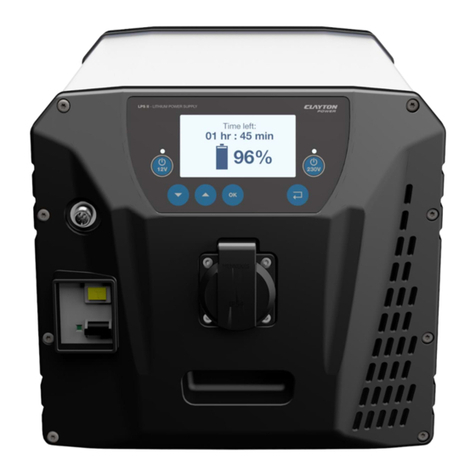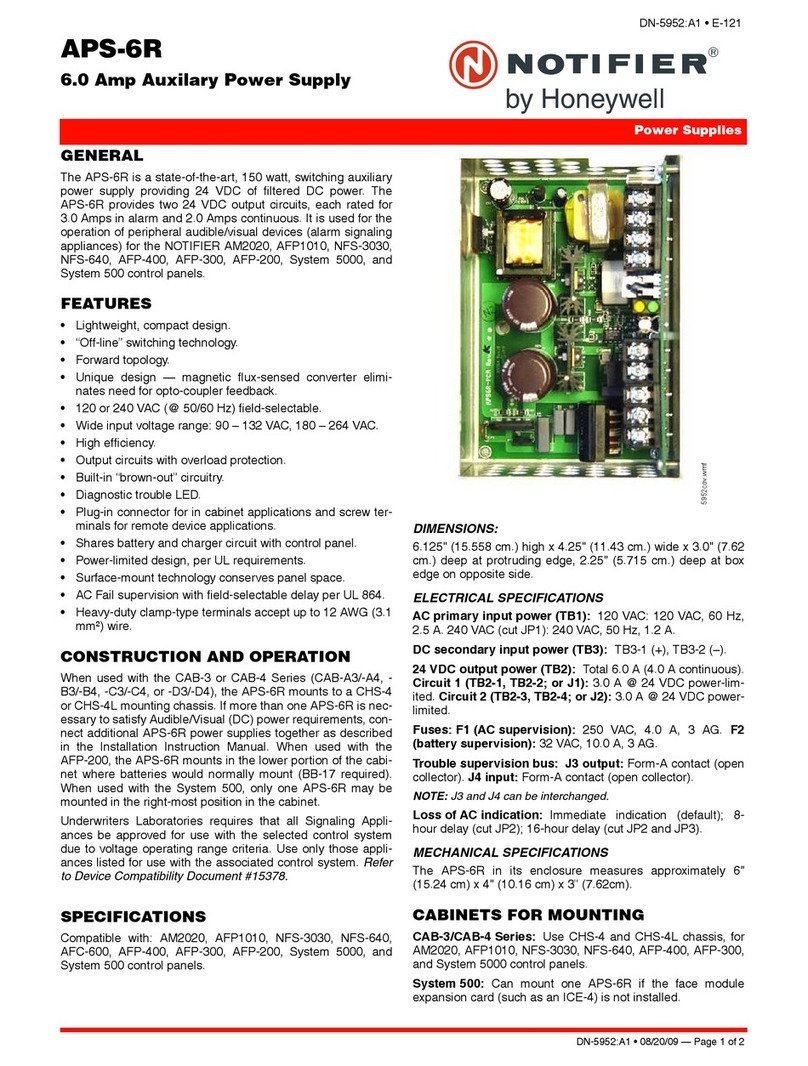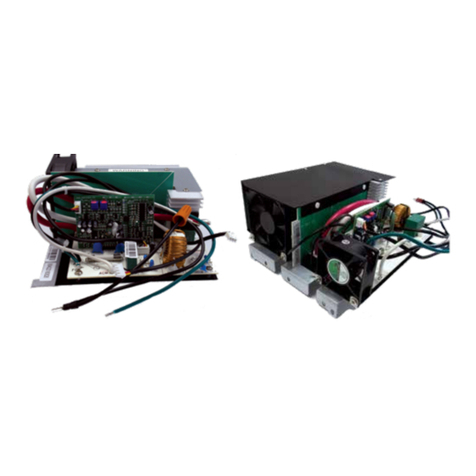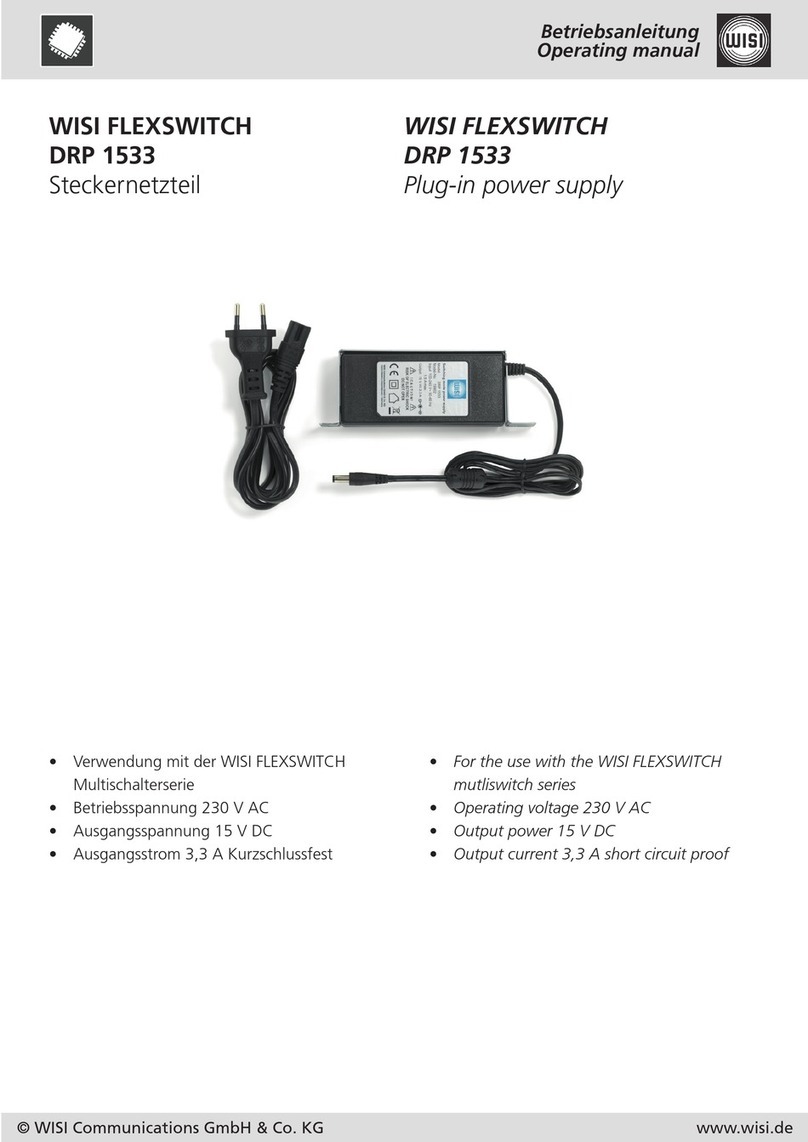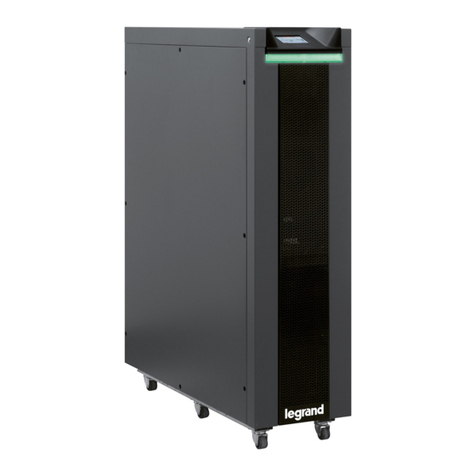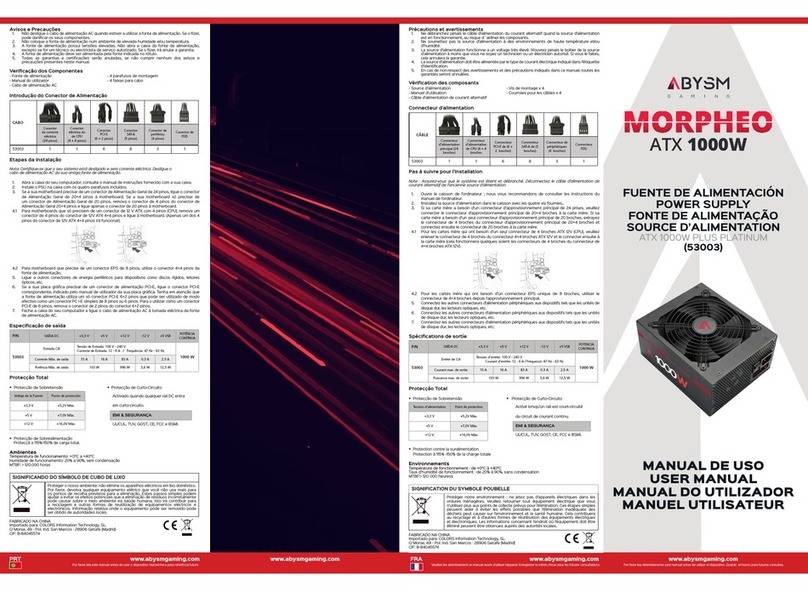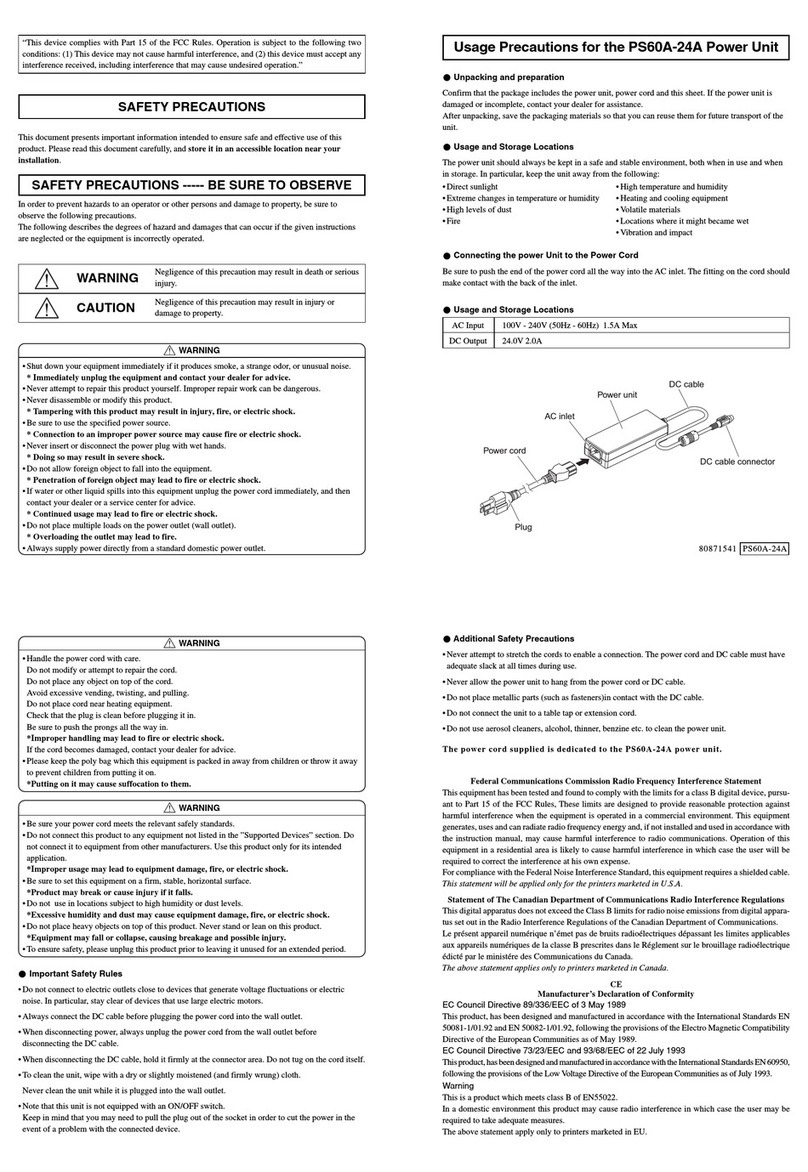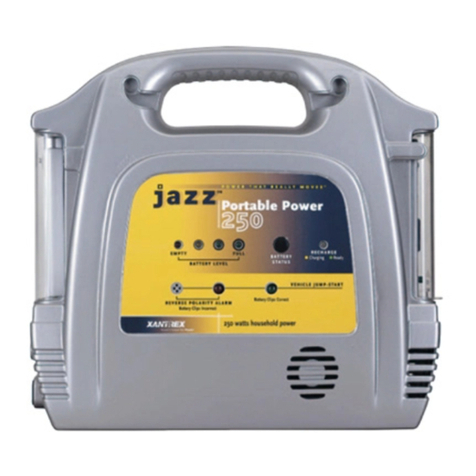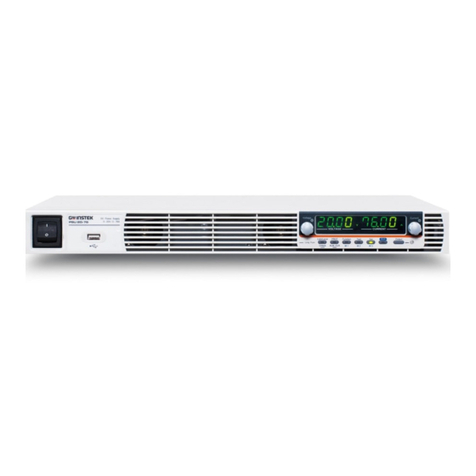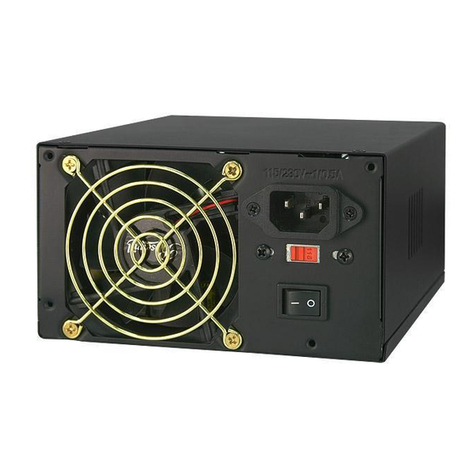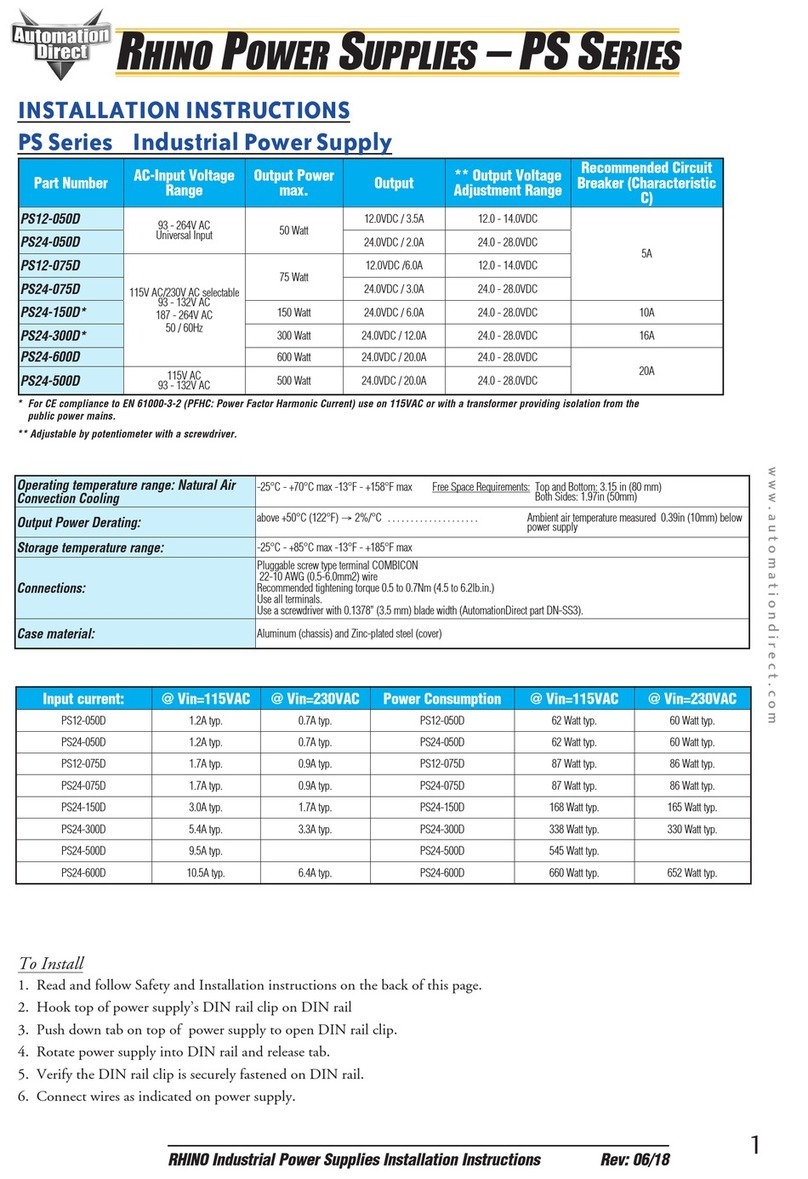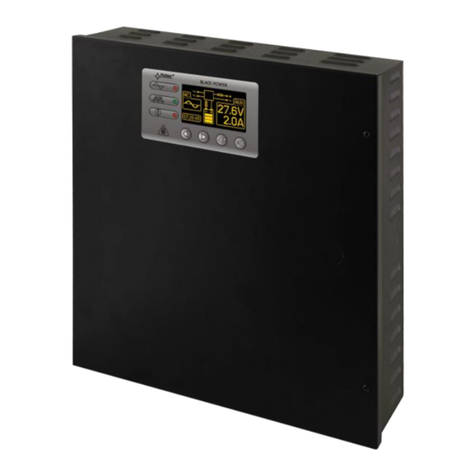Clayton Power LPS II Series Operator's manual

Manual and safety instructions |
English
Revision 2.00
The LPS II range

SAFETY INSTRUCTIONS –UN3480
The Lithium Power Supply (LPS) is classified as Class 9 dangerous goods according to UN3480, a
power source with high energy density and hazardous materials in a sealed metal cabinet.
Installation must follow national safety regulations in accordance with the requirements for enclosure,
installation, creepage, clearance, marking and segregation requirements for the end-use application.
We recommend that installations are performed by authorised professionals. Switch off the system and
check for hazardous voltages before changing any connections!
The Lithium Power Supply must only be serviced by trained personnel.
The lowest ingress protection rating for specific LPS parts is IP20. Ensure that the installation of the
Lithium Power Supply complies with IP20 requirements.
This is a Class I product. Connect only 230V AC from a source connected to protective electrical earth,
including all extension cords between source and the device.
Observe the following:
When connected to 230V input, voltage is present at 230V output, even when the device
is switched off.
Do not open the LPS.
Do not discharge a new LPS until it has been fully charged.
Charge only within the specified limits.
Make sure the LPS is switched off when it is moved and during installing.
Do not mount the LPS upside down or on its side.
Check if the LPS has been damaged during transport.
Do not series- or parallel-connect the 230V of the LPS.
Do not leave outside exposed to the elements.
Do not use at altitudes above 2,000 metres (6,562 feet)
Do not cover or block the fan or air intake to ensure that the battery does not overheat.
Do not allow children or animals to come in contact with the device or connected power supplies.
Solar Connection
Solar connection must not exceed the maximum voltage of 50V.
Danger in case of fire:
Danger of explosion with dust particles.
Decomposition due to fire or heat development emits toxic and corrosive gases.
Combustion gases which strongly irritate the eyes and respiratory organs.
General precautions the driver should observe if these hazards occur:
Switch off the motor.
Place a warning sign on the road to warn others.
Inform others of the dangers and
advise
them to stay away from the wind direction.
Contact the police and fire brigade immediately and inform them that there are lithium batteries
(UN3480) onboard.
Instruction for fire extinguishing:
Extinguish fire with water. If possible, submerge the LPS completely in water.
Extinguishing with water produces fluoride, phosphate, fluoride-oxide and carbon monoxide.
Alternatively, extinguish with a CO2 fire extinguisher.
NON-SPILL
LI-ION BATTERY

CONTENT
SAFETY INSTRUCTIONS – UN3480
CONTENT
1. GETTING STARTED
1.1 PRODUCT BOX CONTENTS
1.2 PRODUCT DETAILS
2. PRODUCT USAGE
2.1 230V AC OUTPUT
2.2 230V AC CHARGING
2.3 12V DC OUTPUT
2.4 12V/24V DC INPUT
2.5 SOLAR CHARGING
3. TIPS AND TRICKS
3.1 LIMIT AC/DC CHARGING POWER
3.2 ACTIVATE JUMPSTART
3.3 BATTERY MAINTENANCE
4. TROUBLESHOOTING
4.1 ERROR LIST
4.2 NO 230 VAC OUTPUT
5. SPECIFICATIONS
6. CERTIFICATIONS AND COMPLIENCE
7. SAFETY AND FUSES
8. STORAGE
9. TRANSPORTATION
10. DISPOSAL
11. WARRANTY
UNIT MUST BE CHARGED
EVERY 6 MONTHS IF NOT
USED

1. GETTING STARTED
1.1 Product Box Contents
QUANTITY
DESCRIPTION
1
AC charging cable (Neutrik – NAC3 FCA)
1
AC output (Neutrik – NAC3 FCB)
4
Cap for M8 bolt
4
M8 bolt
2
M4 bolt
4
Rubber foot
1
Installation guide
1.2 Product Details
LPS II - OVERVIEW
FRONT VIEW
REAR VIEW
#
DESCRIPTION
#
DESCRIPTION
1
Display
13
Ventilation
2
12V DC button
14
DC output terminals
3
230V AC button
15
DC input terminals
4
Navigation button - Down
16
M12 – Data/Remote
5
Navigation button - Up
17
M12 – Data/IO connector
6
Navigation button - Ok
18
C1 (D+/Ignition Signal)
7
Navigation button - Return
19
C2 (Solar +) IO connector
8
M12 – Data/IO connector
20
Type plate
9
Serial number
21
230V AC output port (NAC3 FCB)
10
RCBO
22
230V AC input port (NAC3 FCA)
11
230V AC output port
12
Ventilation/Fan

M12 - IO Pinout
#
FUNCTION
FRONT VIEW
1
Single Wire (Communication)
2
I/O Signal
3
GND
4
CAN High (Communication)
5
CAN Low (Communication)
NOTE: PIN 2 in the M12 connector labeled "REMOTE" is designed to supply power to the LPS Remote. The
LPS Remote is not included and can be purchased separately.
The display features two home screens - a simple view and an advanced view. It is possible to switch
between the screens using the UP and DOWN navigation buttons.
DISPLAY – SIMPLE VIEW
#
DESCRIPTION
VIEW
1
DC input active – Charging from DC source
2
DC output active – I/O activated
3
Solar input active – Charging from solar
panel
4
DC output energy saver timer active
5
AC output energy saver timer active
6
AC input active – Charging from grid
7
AC output active – I/O activated
8
Remaining operation time or time to
charge
9
Graphical indication of state-of-charge
10
Numeric indication of state-of-charge
DISPLAY - ADVANCED VIEW
#
DESCRIPTION
VIEW
1
DC input functionality
2
DC output functionality
3
AC input functionality
4
AC output functionality
5
Solar input active – Charging from solar
panel
6
Power bar for indicating utilization of
function
7
Functionality is active and a transfer of
energy is in process
8
Functionality is active but there is no
energy transfer
9
AC output energy saver timer active
10
Remaining operation time or time to charge
11
Graphical indication of state-of-charge
12
Numeric indication of state-of-charge
NOTE: Interface and product features might vary depending on the model.
The display provides information on the unit operation status and allows for advanced unit configuration.
For detailed guidance on how to configure the LPS using the menu, refer to the "LPS II User interface
- Configuration guide”document available on our website.

2. PRODUCT USAGE
It is recommended to perform a full battery cycle prior to the initial use. This can be done by fully
discharging the battery and then charging it overnight using the 230V input.
The LPS II is a compact power supply designed to provide power for a variety of 230V AC and 12V DC
applications. It comes with built-in:
•LiFePO4 battery.
•230V AC Output – For supplying 230V AC applications.
•230V AC Input – For charging from mains.
•12V DC Output – High power DC output for supplying 12V DC applications.
•12V/24V Input – Bidirectional DCDC converter for 12V/24V applications like:
oVehicle jumpstart
oCharging from alternator.
•Solar Charging – Integrated MPPT for charging from solar panel.
•CANbus communication and I/O interface for interaction with auxiliary equipment and remote
control.
2.1 230V AC Output
The LPS II features two AC output ports, one on the front (CEE 7) and one on the back (NAC3 FCB), which
can be used simultaneously. Both ports are protected against overload and short circuits and are equipped
with RCDO for safety.
Press the 230V button to activate the AC output function. The green LED will light up to confirm activation.
The output will automatically switch off after 1 hour if the power demand is below 20W (Default setting).
NOTE: If there is no 230V AC output when the output is turned ON, check RCBO.
2.2 230V AC Charging
To charge the LPS II from a power outlet, use the provided power cord with the NAC3 FCA connector.
When connected to mains, the unit will begin charging automatically and redirect the mains to the AC
output ports. During charging, the green 230V LED will flash.
WARNING: 230V AC will always be present on the AC output ports during AC charging.

2.3 12V DC Output
The LPS II has a 12V DC port for providing
power to DC applications. To activate the
12V DC output, press the "12V" button. A
green LED will light up, indicating that the
functionality is active.
WARNING: Using the wrong cable size or a
bad cable connection can cause
overheating and a short circuit.
WARNING: Place a correctly dimensioned
fuse (max. 200A) as close as possible to the
LPS to prevent high current short-circuits.
2.4 12V/24V DC Input
The LPS II can be charged using the built-in DCDC converter when the DC IN port voltage is within the
operational range and a wakeup signal is detected on C1.
WARNING: Using the wrong cable size or a bad cable connection can cause overheating and a short
circuit.
WARNING: Place a fuse as close as possible to the power source to prevent high current short-circuits.
2.5 Solar Charging
If the solar panels generate enough power
(> 5W), the LPS II will automatically charge
using the integrated MPPT.
WARNING: Never exceed 50Voc between
DC Input minus and C2 from solar.
Exceeding may cause damage to the unit.
NOTE:
Not available in LPS 1500 SE
variant.

3. TIPS AND TRICKS
3.1 Limit AC/DC charging power
If the power source has limited output, the AC and DC charging can be limited. The below setting will
also limit the AC output in the LPS while connected to the mains.
Limiting AC charging power using display
Menu Path
Description
Main Menu > 230V AC Charging >
Maximum current
To set the maximum allowable
current for AC charging, enter the
menu and navigate using the up and
down arrows. Press "OK" to confirm
your selection. This setting will take
effect immediately.
NOTE: If 230V charge is limited, the 230V output in the LPS is also limited while connected to the
mains.
Limiting DC charging power using display
Menu Path
Description
Main Menu > DC Charging > Set
current
To set the maximum allowable
current for DC charging, enter the
menu and navigate using the up and
down arrows. Press "OK" to confirm
your selection. This setting will take
effect immediately.
3.2 Activate Jumpstart
The LPS II has an integrated jumpstart feature that can charge the starter battery if depleted. To use
this feature, the LPS must be connected to the starter battery via the DCIN terminal according to section
2.4.
The jumpstart is activated through the display menu or the remote. Once activated, the jumpstart will
charge the starter battery for 5 min with 40A.
Activate Jumpstart using display
Menu Path
Description
Main Menu > DC Charging >
Jumpstart functionality
To activate the jumpstart function,
enter the menu and use the up and
down arrow to select "Active" and
press "OK" to confirm.
3.3 Battery maintenance
To ensure optimal battery performance, fully recharge the battery every month (100%).
NOTE: If the battery has not been fully charged for a long period, maintenance charge can be
prolonged to 3 days.

4. TROUBLESHOOTING
4.1 Error list
If the solutions provided below are unable to resolve the error or if the error code is not listed, contact
your retailer.
ERROR
DESCRIPTION
SOLUTION
PRODUCT TEMPERATURE
4, 5,
56, 57,
123
Unit temperature too low
Let the device warm up or move it to a place with a
higher ambient temperature
6, 7,
58, 59
Unit temperature too high
Let the device cool down or move it to a place with a
lower ambient temperature
I/O & COMMUNICATION
11, 12,
13
M12 connector is overloaded
or has short circuited
Disconnect connector and check connector or cable
for damage
14
IO Terminal is overloaded or
has short circuited
Disconnect connector and check connector or cable
for damage
121
Communication Error
Verify cable connections on M12 connectors
BATTERY
51, 52,
53, 60
Battery/Cell voltage low
Recharge the battery
SOLAR
70
Solar input voltage too high
Check the installation and max. voltage from solar
panel (50V)
DC INPUT
90, 92
The DC Input voltage too low
Provide a higher 12V DC or 24V DC voltage
91,
124,
125
The DC Input voltage too high
Provide a lower 12V DC or 24V DC voltage
DC OUTPUT
96
DC Output charge current too
high
Remove or adjust the power source
97
DC Output discharge current
too high
The 12V DC Output load is drawing too much current.
Remove the load
AC OUTPUT
150,
151,
152,
203
230V AC Output is
overloaded
Remove load on the 230V AC Output
AC INPUT
206
230V AC mains is too low
Check supply cables or try another outlet socket
207
230V AC mains too high
Mains too high, verify outlet socket voltage
4.2 No 230 V AC output
Make sure that the Residual Current Circuit Breaker with Overload protection (RCBO) is switched on
(see section 1.2 - #10) and check your AC cables.

5. SPECIFICATIONS
PARAMETER
LPS II 1500 W
1 kWh SE
LPS II 2000
1 kWh
LPS II 2500
1 kWh
LPS II 3000
2 kWh
GENERAL SPECIFICATION
Model no.
CL2204/CL2214
CL2205/CL2215
CL2102/CL2112
CL2103/CL2113
Cooling
Forced air
Forced air
Forced air
Forced air
Operating
temperature
discharge
-20 ~ 50°C -20 ~ 50°C -20 ~ 50°C -20 ~ 50°C
Operating
temperature charge
0 ~ 50°C 0 ~ 50°C 0 ~ 50°C 0 ~ 50°C
IP classification
IP20
IP20
IP20
IP20
Protection class
I
I
I
I
Maximum altitude
2,000 m
2,000 m
2,000 m
2,000 m
Product weight
22.5 kg
22.5 kg
23.5 kg
27.5 kg
Product size (H x W
x L)
256 x 277 x 409
mm
256 x 277 x 409
mm
256 x 277 x 409
mm
256 x 277 x 409
mm
Gross weight
25.5 kg
25.5 kg
26.5 kg
30.5 kg
Package size (H x
W x L)
320 x 372 x 480
mm
320 x 372 x 480
mm
320 x 372 x 480
mm
320 x 372 x 480
mm
BATTERY
Type
Rechargeable Lion
battery system
Rechargeable Lion
battery system
Rechargeable Lion
battery system
Rechargeable Lion
battery system
Chemistry
LiFePO4
LiFePO4
LiFePO4
LiFePO4
Capacity
100 Ah (1,280 Wh)
100 Ah (1,280 Wh)
100 Ah (1,280 Wh)
160 Ah (2,048 Wh)
Available capacity
80 Ah (1,020 Wh)
80 Ah (1,020 Wh)
80 Ah (1,020 Wh)
136 Ah (1,740 Wh)
Cycles
2,000
2,000
2,000
3,500
Self-discharge rate
per month
<5% <5% <5% <5%
Marking (IEC 61960)
4IFpP51/161/119
4IFpP51/161/119
4IFpP51/161/119
4IFpP55/175/154
Marking (IEC 62620)
IFpP/51/161/119/[4
S]M/-20+60/90
IFpP/51/161/119/[4
S]M/-20+60/90
IFpP/51/161/119/[4
S]M/-20+60/90
IFpP/55/175/154/[
4S]M/-30+60/90
AC INPUT
Voltage
207 - 253 V AC
207 - 253 V AC
207 - 253 V AC
207 - 253 V AC
Frequency
45 - 65 Hz
45 - 65 Hz
45 - 65 Hz
45 - 65 Hz
Power
550 W
720 W
720 W
720 W
Connector type
NAC3 FCA
NAC3 FCA
NAC3 FCA
NAC3 FCA
AC OUTPUT
Voltage (+- 10%)
230 V AC pure
sine wave
230 V AC pure
sine wave
230 V AC pure
sine wave
230 V AC pure
sine wave
Frequency
50 Hz
50 Hz
50 Hz
50 Hz
Power - continuous
(@25°C)
1,300 W 1,500 W 2,000 W 2,300 W
Power - 10 min.
1,500 W
2,000 W
2,500 W
3,000 W
Power - peak
2,600 W
3,000 W
4,000 W
5,000 W
Power - AC in
connected
2,300 W 2,300 W 3,000 W 3,000 W
Efficiency (1,000 W)
94%
94%
94%
94%
Power factor range
0.77
0.77
0.77
0.77
Idle consumption
20W
20W
30W
30W
Fault current (rms)
30mA
30mA
30mA
30mA
Connector type
NAC3 FCB
NAC3 FCB
NAC3 FCB
NAC3 FCB
DC INPUT
Voltage
11.5 - 32 V DC
11.5 - 32 V DC
11.5 - 32 V DC
11.5 - 32 V DC
Current
25 A
45 A
45 A
45 A
Jumpstart
25 A/5 min.
40 A/5 min.
40 A/5 min.
40 A/5 min.
Connector type
Terminal – M8
Terminal – M8
Terminal – M8
Terminal – M8

PARAMETER
LPS II 1500 SE
LPS II 2000
LPS II 2500
LPS II 3000
DC OUTPUT
Voltage
10 - 14.4 V DC
10 - 14.4 V DC
10 - 14.4 V DC
10 - 14.4 V DC
Discharge current -
continuous
180 A 180 A 180 A 180 A
Discharge current -
1 min.
270 A 270 A 270 A 350 A
Idle consumption
<1 W
<1 W
<1 W
<1 W
Charging current –
continuous
90 A 90 A 90 A 90 A
Super charge
support
No Yes Yes Yes
Connector type
Terminal – M8
Terminal – M8
Terminal – M8
Terminal – M8
SOLAR (INPUT)
Voltage
N/A
15 - 50 V DC
15 - 50 V DC
15 - 50 V DC
Charging power
(max.)
N/A 400 W 400 W 400 W
Charging current
(max.)
N/A 15 A 15 A 15 A
Absolute maximum
current (Isc)
N/A 30A 30A 30A
I/O
Input ports
(Analog)
C1, C2, M12 C1, C2, M12 x 3 C1, C2, M12 x 3 C1, C2, M12 x 3
Input (Voltage –
M12)
0 – 36V 0 – 36V 0 – 36V 0 – 36V
Input (Voltage – C1,
C2)
0 – 50V 0 – 50V 0 – 50V 0 – 50V
Output ports
(Digital)
C2 and M12 C2 and M12 x 3 C2 and M12 x 3 C2 and M12 x 3
Output (Voltage)
0 or 12V
0 or 12V
0 or 12V
0 or 12V
Output (Current)
400 mA
(Over current
protected)
400 mA
(Over current
protected)
400 mA
(Over current
protected)
400 mA
(Over current
protected)
Connector type
(M12)
Type A – 5-way Type A – 5-way Type A – 5-way Type A – 5-way
Connector type
(C1/C2)
Terminal – M4 Terminal – M4 Terminal – M4 Terminal – M4

6. CERTIFICATIONS AND COMPLIANCE
Low Voltage Directive 2014/35/EU
EN62368-1, EN62133
EMC
2014/30/EU
EN61000-6-2, EN61000-6-3
RoHS Directive 2011/65/EU
EN
63000
E-M
arking
UN-ECE Regulation 10, E5 10R – 06 0488

7. SAFETY AND FUSES
These measures ensure the safe and secure operation of the electrical system:
•230V AC input protected with 16A fuse.
•230V AC output protected by a Residual Current Circuit Breaker with Overload protection
(RCBO) 30mA/13A.
•DC input protected with 50A fuse.
•DC output protected with 180A fuse.
•L/N relay hardware protection against hazards.
•PE/N relay hardware protection against hazards.
•Solar panels 20A fuse.
Fuses cannot be replaced by the user and require service.
ATTENTION: The MPPT/Solar may be permanently damaged if the input voltage exceeds 50V.
ATTENTION: The device is equipped with a Residual Current Circuit Breaker with Overload
protection (RCBO). To ensure its proper operation, it is important to regularly test the RCBO.
Procedure:
•Ensure that 230V AC is present.
•Locate the button marked 'T' on the RCBO.
•Press the 'T' button.
•Observe the RCBO to ensure that it trips during the test.
If the RCBO becomes disabled, all 230AC output ports will be disconnected. This is a safety feature to
protect the device and those using it. Regular testing of the RCBO ensures that it is functioning properly.
ATTENTION: Protective Earth - The device must have protective earth connected.
It is mandatory to install a Protective Earth (PE) connection in accordance with the
requirements specified in IEC 62109-1. The PE connection provides a safe route for
electrical fault current to flow, reducing the risk of electric shock and fire. Proper
installation of the PE connection is essential for ensuring the safety of users and the
equipment. Make sure that the PE connection is installed using appropriate materials
and methods, in accordance with the relevant national and local regulations.

8. STORAGE
The battery can be stored at temperatures between -20⁰C and 45⁰C. For long term storage (>1 month), the
battery should be fully charged and stored at temperatures between 0⁰C and 35⁰C. The battery needs to be
charged every 6 months if not used. Do not store the battery upside down.
9. TRANSPORTATION
Lithium batteries are classified as Class 9 hazardous materials (UN3480) and must always be transported in
compliance with all applicable local, national, and international regulations. Proper packaging is required
during transportation, and packaging instructions (PI965) must be respected. The batteries should not be
turned upside down during transportation.
10. DISPOSAL
To ensure proper disposal and reduce potential hazards, discharge the battery completely before placing it in
a designated battery recycling bin. Improper disposal, such as throwing it in regular rubbish bins, is strictly
prohibited as the product contains batteries with potentially harmful chemicals. Adhere to local laws and
regulations for battery recycling and disposal.

11. WARRANTY
IMPORTANT AND WARNING:
DO NOT USE OR ATTEMPT TO USE THIS PRODUCT UNTIL YOU HAVE READ THE USER
MANUAL
IN ITS ENTIRETY. IMPROPER INSTALLATION OR USE OF THIS DEVICE MAY BE
DANGEROUS AND
MAY CAUSE DAMAGE TO OTHER ELECTRICAL EQUIPMENT AND WILL
VOID THE WARRANTY.
Warranty. The company guarantees that products and associated services are free of significant
defects in design, material and execution for 24 months after delivery.
Exceptions. The company’s warranty does not include defects caused by: (i) ordinary wear and tear,
(ii) storage, installation, use or maintenance against the company’s instructions or ordinary practice,
(iii) repair or change carried out by others than the company, and (iv) other conditions for which the
company has no responsibility.
Examination. Within a reasonable period of time after receiving a complaint from the client about
defects and examining the claim, the company will inform the client about whether or not the defects
are covered by the warranty. After the request, the client must ship defect parts to the company.
The client covers the expenses and risks of the parts during transport to the company. The company
covers the expenses and risks for return of parts during transport, only if the defects are covered by
the warranty.
Register a complaint. If the client discovers defects within the period of warranty, which the client
wishes to invoke, it must be communicated immediately in writing. If defects, which the client
discovers or should have been discovered, are not immediately communicated to the company in
writing, it cannot be effectuated at a later time. The client must provide the company the requested
information about the registered defects.
Instructions for Obtaining Warranty Service for Clayton Power Devices
To obtain warranty service, contact the store where you have bought the product and
provide the following:
•
Sales receipt
•
Device model number
•
Device serial number
•
Brief description of the application and problem, including any error codes
displayed on the device.
•
Obtain an authorisation number from the Clayton Power dealer before shipping the
device. Carefully pack the device and ship it (freight paid) to the Clayton Power
dealer. Note that the device contains lithium batteries and must be shipped as
dangerous goods according to UN3480 lithium-ion batteries’ regulations.
Other manuals for LPS II Series
2
This manual suits for next models
8
Table of contents
Other Clayton Power Power Supply manuals

